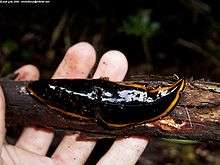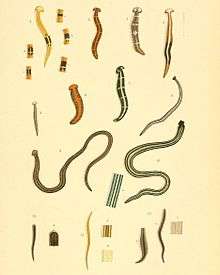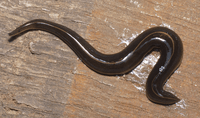Geoplanidae
| Geoplanidae | |
|---|---|
 | |
| Geoplana burmeisteri from the Atlantic rainforests of southern Brazil | |
| Scientific classification | |
| Kingdom: | Animalia |
| Phylum: | Platyhelminthes |
| Class: | Turbellaria |
| Order: | Tricladida |
| Suborder: | Continenticola |
| Family: | Geoplanidae Stimpson, 1857 |
| Subfamilies[1] | |
| |
Geoplanidae is a family of flatworms known commonly as land planarians. It is an understudied but important group of organisms of soil ecosystems.[2]
These flatworms are predators of other invertebrates such as earthworms, snails, slugs, insects and chelicerates, which they hunt, attack and capture using physical force and the adhesive and digestive properties of their mucus.[3] They lack water-retaining mechanisms and are therefore very sensitive to humidity variations of their environment.
Because of their strict ecological requirements, some species have been proposed as indicators of the conservation state of their habitats.[4][5] They are generally animals with low vagility (dispersal ability) and with very specific habitat requirements, so they can be also used to accurately determine the distribution of biogeographic zones. Today the fauna of these mostly rather fragile animals is being studied to select conservation priorities in the Atlantic rainforest in Brazil.[6]
At the other extreme, one species in this family, Platydemus manokwari has become an invasive species in both disturbed and wild habitats in the Pacific Islands, and has damaged the endemic land snail faunas. This species has been found in Europe (France) in 2013 for the first time,[7] and in 2015 in New Caledonia, Wallis and Futuna Islands, Singapore, Solomon Islands, Puerto Rico (first record in the Caribbean), and Florida, USA.[8]
Diversity
The family Geoplanidae is composed of four subfamilies:
- Rhynchodeminae
- Bipaliinae
- Geoplaninae
- Microplaninae
Although there are over 830 known species of Geoplanidae in the world,[9] the diversity of land planarians is still poorly known.
Feeding and predatory behavior

"If contact with food is made, and the planarian is ready to feed, arousal and predatory behaviour will occur" (Neck, 1987)
Despite their delicate aspect, these terrestrial flatworms are voracious predators. All planarians feed through a muscular and eversible pharynx located in ventral side of the body. The pharynx is an extensible tube-like mouth, it bears a complex muscular coat that specializes as a penetration organ for those planarians that feed on arthropods; or as a grasping organ for those planarians that feed on other soft bodied invertebrates such as earthworms. All geoplanidae pharynxes are equipped with glandular secretions that externally digest and dissolve their prey.[3]
As part of the soil ecosystem, land planarians feed mainly on other invertebrates. Some species of land planarians have become invasive pest species. The New Zealand flatworm Arthurdendyus triangulatus and the Australian flatworm Caenoplana alba have been introduced in the British Isles and are considered to be pest species because they prey upon earthworms and thus may negatively affect soil structure and fertility. A species of land planarian, Platydemus manokwari, has been used as an agent of biological pest control of the introduced giant African snail Achatina fulica in Hawaii, the Maldives, Irian Jaya, and Guam.
Some land planarians show hunting behaviour, using chemical signals to detect their prey. Most land planarians have chemical sensory organs in the anterior part of the body, such as sensory pits and epidermal folds which serve as chemical radars for detecting their food. The mucus trails from the slime of slugs, snails and other planarians orient planarians towards their prey.[10][11] Different species use different techniques for capturing and immobilizing their prey, such as entrapment with sticky mucus and immobilization by physical force.
Cannibalism has been observed in land planarians.
Phylogeny and Systematics

Until very recently, land planarians were classified as a suborder within Tricladida, named Terricola. However, recent phylogenetic studies revealed that they are actually the sister-group of Dugesiidae, a family of freshwater planarians (at that time part of the suborder Paludicola).[1] The most recent classification puts both land and freshwater planarians within a single suborder called Continenticola, with land planarians forming a single family, Geoplanidae.
The following phylogenetic supertree after Sluys et al., 2009[1] presents the current classification of planarians:
| Tricladida |
| ||||||||||||||||||||||||||||||||||||
| |
In the former suborder Terricola, land planarians were separated into three families according to morphological features:[12][13]
- Bipaliidae: head expanded in a spatula-like shape and multiple eyes;
- Rhynchodemidae: non-expanded head and a single pair of eyes. It included two subfamilies: Rhynchodeminae, with subepithelial longitudinal muscular fibers grouped into large bundles, and Microplaninae, with weaker subepithelial longitudinal muscular fibers not forming bundles;
- Geoplanidae: non-expanded head and multiple eyes. It included three subfamilies: Geoplaninae, with dorsal testicles and strong subepithelial longitudinal muscles, Caenoplaninae, with ventral testicles and strong subepithelial longitudinal muscles, and Pelmatoplaninae, with ventral testicles and weak subepithelial longitudinal muscles.
Recent phylogenetic analyses, however, revealed that Rhynchodeminae and Microplaninae are not closely related and that Caenoplaninae is closer to Rhynchodeminae than to Geoplaninae. The current classification of land planarian subfamilies is shown in the following phylogenetic tree after Álvarez-Presas et al., 2008.[14] The old subfamilies Caenoplaninae and Pelmatoplaninae have been included as tribes Caenoplanini and Pelmatoplanini inside Rhynchodeminae.[1] Note that Spathula and Romankenkius belong to the Dugesiidae family. Their relocation inside Geoplanidae needs further investigation.[14]
| Geoplanoidea |
| ||||||||||||||||||||||||||||||||||||
| |
Image gallery
- Land planarians, showing a variety of forms and colors
-

Geoplana ladislavii from a garden in Porto Alegre, southern Brazil.
-

Geoplaninae sp. from Valdivian Rainforest in southern Chile.
-

Pseudogeoplana reticulata from Valdivian Rainforest
-
Caenoplana coerulea, the blue planarian, in Australia.
-

Platydemus manokwari in France
-

Platydemus manokwari, detail of dorsal longitudinal stripe
-

Platydemus manokwari in New Caledonia
-

Platydemus manokwari in Singapore
-

Platydemus manokwari in Tahiti
References
- 1 2 3 4 Sluys, R.; Kawakatsu, M.; Riutort, M.; Baguñà, J. (2009). "A new higher classification of planarian flatworms (Platyhelminthes, Tricladida)". Journal of Natural History 43 (29–30): 1763–1777. doi:10.1080/00222930902741669.
- ↑ Winsor, L., P. M. Johns, and G. M. Yeates. 1998. Introduction, and ecological and systematic background, to the Terricola (Tricladida). Pedobiologia 42(5-6), 389-404.
- 1 2 Ogren, R. E. (1995). "Predation behaviour of land planarians". Hydrobiologia 305: 105–111. doi:10.1007/BF00036370.
- ↑ Sluys, R. (1999). "Global diversity of land planarians (Platyhelminthes, Tricladida, Terricola): a new indicator-taxon in biodiversity and conservation studies". Biodiversity and Conservation 8 (12): 1663–1681. doi:10.1023/A:1008994925673.
- ↑ Carbayo, F.; Leal-Zanchet, A. M.; Vieira, E. M. (2002). "Terrestrial flatworm (Platyhelminthes: Tricladida: Terricola) diversity versus man-induced disturbance in an ombrophilous forest in southern Brazil". Biodiversity and Conservation 11 (6): 1091–1104. doi:10.1023/A:1015865005604.
- ↑ Álvarez-Presas, M.; Sánchez-Garcia, A.; Carbayo, F.; Rozas, J.; Riutort, M. (2014). "Insights into the origin and distribution of biodiversity in the Brazilian Atlantic forest hot spot: a statistical phylogeographic study using a low-dispersal organism". Heredity 112: 656–665. doi:10.1038/hdy.2014.3.
- ↑ Justine, Jean-Lou; Winsor, Leigh; Gey, Delphine; Gros, Pierre; Thévenot, Jessica (2014). "The invasive New Guinea flatworm Platydemus manokwari in France, the first record for Europe: time for action is now.". PeerJ 2: e297. doi:10.7717/peerj.297. PMC 3961122. PMID 24688873.

- ↑ Justine, Jean-Lou; Winsor, Leigh; Barrière, Patrick; Fanai, Crispus; Gey, Delphine; Han, Andrew Wee Kien; La Quay-Velázquez, Giomara; Lee, Benjamin Paul Yi-Hann; Lefevre, Jean-Marc; Meyer, Jean-Yves; Philippart, David; Robinson, David G.; Thévenot, Jessica; Tsatsia, Francis (2015). "The invasive land planarianPlatydemus manokwari(Platyhelminthes, Geoplanidae): records from six new localities, including the first in the USA". PeerJ 3: e1037. doi:10.7717/peerj.1037. ISSN 2167-8359.

- ↑ Schockaert, E. R., et al. 2008. Global diversity of free living flatworms (Platyhelminthes, "Turbellaria") in freshwater. Hydrobiologia 198, 41-48.
- ↑ Fiore, C.; Tull, J. L.; Zehner, S.; Ducey, P. K. (2004). "Tracking and predation on earthworms by the invasive terrestrial planarian Bipalium adventitium (Tricladida, Platyhelminthes)". Behavioural Processes 67 (3): 327–334. doi:10.1016/j.beproc.2004.06.001. PMID 15518983.
- ↑ Iwai, N.; Sugiura, S.; Chiba, S. (2010). "Prey-tracking behavior in the invasive terrestrial planarian Platydemus manokwari (Platyhelminthes, Tricladida)". Naturwissenschaften 97 (11): 997–1002. doi:10.1007/s00114-010-0717-4. PMID 20853096.
- ↑ Ogren, R. E. and Kawakatsu, M. (1988) "Index to the species of the family Rhynchodemidae (Turbellaria, Tricladida, Terricola) Part I: Rhynchodeminae". Bulletin of Fuji Women's College 26 (2): 39-91.
- ↑ Ogren, R. E. and Kawakatsu, M. (1991) "Index to the species of the family Geoplanidae (Turbellaria, Tricladida, Terricola) Part II: Caenoplaninae and Pelmatoplaninae".: Bulletin of Fuji Women's College 29 (2): 35-58.
- 1 2 Álvarez-Presas, M.; Baguñà, J.; Riutort, M. (2008). "Molecular phylogeny of land and freshwater planarians (Tricladida, Platyhelminthes): From freshwater to land and back". Molecular Phylogenetics and Evolution 47 (2): 555–568. doi:10.1016/j.ympev.2008.01.032. PMID 18359250.
External links
| Wikimedia Commons has media related to Geoplanidae. |

